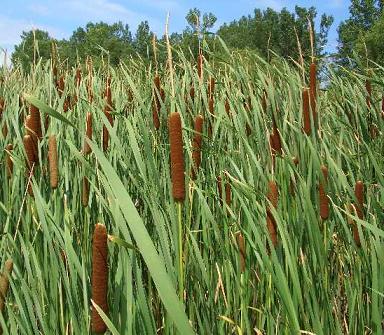New Account | Seed Mix |
Gift Certificates |AAS Winners |
Gardening Products
SEEDS: Unusual | Annuals | Perennials | Vegetables | Herbs | Trees
Narrow Leaf Cattail Seeds

LET710 Narrow Leaf Cattail ( Typha angustifolia )
The word suf is the word for "reeds" or "rushes," the word used in Exodus 2:3, 5 to describe where Moses' basket was placed in the Nile. So, the biblical reference throughout the Old Testament is to the "sea of reeds" (e.g., Numbers 14:25, Deuteronomy 1:40, Joshua 4:23, Psalms 106:7. etc.). In Exodus and Isaiah suf can be translated as Typha; in Egypt it was called tupai.
A unique and useful plant for wet areas. It can be used in water gardens, bog gardens, ponds. It will naturalize in wetland areas. Flower spikes are very popular additions to dried flower arrangements.
Narrowleaf cattail is easily identifiable from a distance because of its distinctive, narrow, blade-like green leaves (each to 5' long and 5/16" wide) and its stiff unbranched flower stalk which blooms from May to July and is topped by a poker-like, sausage-brown flower spike (5/8 to 1 1/4" diameter) which purportedly resembles a cattail.
A marginal, semi-aquatic, herbaceous perennial that typically grows from extensive creeping rhizomes to 3-7’ tall, often forming, over time, dense stands of robust spreading vegetation. It is native to wet, often mucky soils, including areas of shallow water to 12" deep, in fresh and brackish marshes, swamps, ditches, water margins of rivers and ponds, and along various other wetland areas in North America, Europe and Asia.
Narrowleaf cattail has year-round edible uses: (a) the peeled rhizomes can be cooked like potatoes or dried and made into protein-rich flour which can be added as a thickener for soups; (b) the young spring shoots are juicy with a nutty flavor and can be used as an asparagus substitute; (c) the young immature flowers can be boiled and eaten somewhat like corn on the cob; (d) the base of the leaves can be eaten like an artichoke; (e) the flowers can be eaten raw or cooked. Leaves are not edible but may be woven into mats, seats and baskets.
Typha can be used as a source of starch to produce ethanol. Because of their high productivity in northern latitudes, Typha are considered to be a bioenergy crop. A perennial plant for zones 2-11.
A unique and useful plant for wet areas. It can be used in water gardens, bog gardens, ponds. It will naturalize in wetland areas. Flower spikes are very popular additions to dried flower arrangements.
Narrowleaf cattail is easily identifiable from a distance because of its distinctive, narrow, blade-like green leaves (each to 5' long and 5/16" wide) and its stiff unbranched flower stalk which blooms from May to July and is topped by a poker-like, sausage-brown flower spike (5/8 to 1 1/4" diameter) which purportedly resembles a cattail.
A marginal, semi-aquatic, herbaceous perennial that typically grows from extensive creeping rhizomes to 3-7’ tall, often forming, over time, dense stands of robust spreading vegetation. It is native to wet, often mucky soils, including areas of shallow water to 12" deep, in fresh and brackish marshes, swamps, ditches, water margins of rivers and ponds, and along various other wetland areas in North America, Europe and Asia.
Narrowleaf cattail has year-round edible uses: (a) the peeled rhizomes can be cooked like potatoes or dried and made into protein-rich flour which can be added as a thickener for soups; (b) the young spring shoots are juicy with a nutty flavor and can be used as an asparagus substitute; (c) the young immature flowers can be boiled and eaten somewhat like corn on the cob; (d) the base of the leaves can be eaten like an artichoke; (e) the flowers can be eaten raw or cooked. Leaves are not edible but may be woven into mats, seats and baskets.
Typha can be used as a source of starch to produce ethanol. Because of their high productivity in northern latitudes, Typha are considered to be a bioenergy crop. A perennial plant for zones 2-11.
For over a thousand more unique seed varieties, all in stock and ready to ship, visit our Seed Catalog Index Page .

